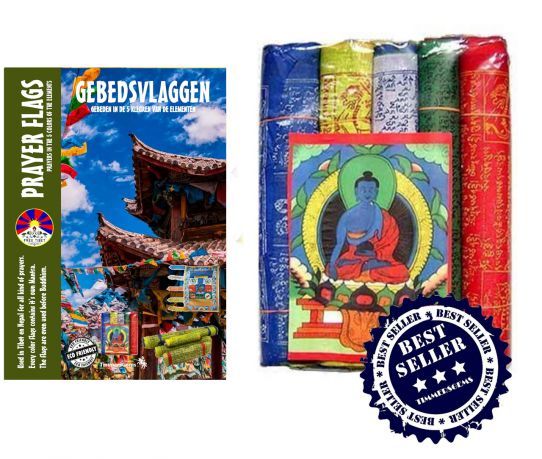We use cookies to make your experience better.
Garland Tibetan prayer flags medium made in Tibet.
- Buy 50 for €1.65 each and save 17%
- Buy 100 for €1.45 each and save 27%
Tibetan prayer flags are colored rectangular pieces of cloth printed with prayers and mantras and hung in garlands on mountain passes, temples and rocky peaks in the Himalayas. Prayer Flags are only found in Tibetan Buddhism, and are believed to originate from the ancient böngeloof, which was confessed before the rise of Buddhism in Tibet. There are two kinds of prayer flags: more or less square lung ta (Tibetan for "wind horse") flags that are hung in garlands; and vertical darchor flags. Garlands of lung ta flags are between two high points, such as rocky outcrops or roofs of temples and stupas, or from a high point diagonally strung down. The vertical darchor flags are usually fixed to poles that are present in the ground or on roofs. Traditionally prayer flags in sets of five, one for each primary color plus white and green. The five colors represent the five elements. Blue stands for "heaven", white for "wind", red for "fire", green for "water" and yellow for "earth." At the same time, each color for one of the five Dhyani Buddhas: blue for Akshobhya Buddha, white for Ratnasambhava Buddha, Amitabha Buddha for red, green and yellow for Amoghasiddhi Buddha to Buddha Vairocana. In böngeloof were priests flags with these five colors used in ritual ceremonies. According to Tibetan medicine health is the result of harmony and balance between the five elements. At the center of a flag is a picture of a ta (a strong horse) bearing three jewels on his back. The ta symbolizes speed and converting misfortune to prosperity. The three jewels symbolize the Buddha, the Dhamma (Buddhist teachings) and the Sangha (the Buddhist community), the three cornerstones of Tibetan Buddhism. Around the ta are different variations on around twenty traditional mantras, each targeted to a specific deity (in Tibetan Buddhism are gods rather than separate personalities but rather several "aspects of the divine"). Some of these mantras are attributed to three important Tibetan Bodhisattvas:
Padmasambhava, Tsjenrezig (the patron of the Tibetan people) and Manjushri. Often alongside the mantras prayers for a long and prosperous life of the person hanging the flag. Images or names of four legendary animals are in the corners of the flag: the dragon, the garuda, the tiger and the snow lion. Prayer Flags are supposed to spread peace, compassion, strength and wisdom. Tibetans believe that when fluttering in the wind take off the mantras and prayers to the gods, which bring prosperity to the hanger, his family, friends, acquaintances and even enemies. The flags in high places can depend on the ta, the wind horse, bring blessings to all living beings. In addition, the air is purified by the flags itself. Old flags often lose weathers their colors. It is believed that this is because the prayers are absorbed slowly in the environment. Just as life is a cycle of death and rebirth, new Tibetan flags hang alongside the old, to symbolize the self-renewing aspect to life. The flags are printed using block printing. During the Cultural Revolution in China, which is even more around value in the Chinese occupied Tibet prayer flags were banned. Probably many traditional designs were lost. Nowadays hang in Tibet and the Tibetan refugees through inhabited areas in India different designs. Most flags are now made in India or Nepal by Tibetan refugees of Nepalese Buddhists. In Bhutan are also locally produced flags. The different colors must from left to right are suspended in the following order: blue, white, red, green and yellow. Sometimes it is thought that if the flags are hung on a wrong date or time, according to Tibetan astrology, it negatively affects their performance. The best time to hang flags would be on a windy sunny day in the morning. During the Tibetan New Year are flocking old flags replaced. As the symbols and mantras on the flags are sacred, for example, flags may not be placed on the ground or incorporated into clothing. Old removed flags should be burned.












